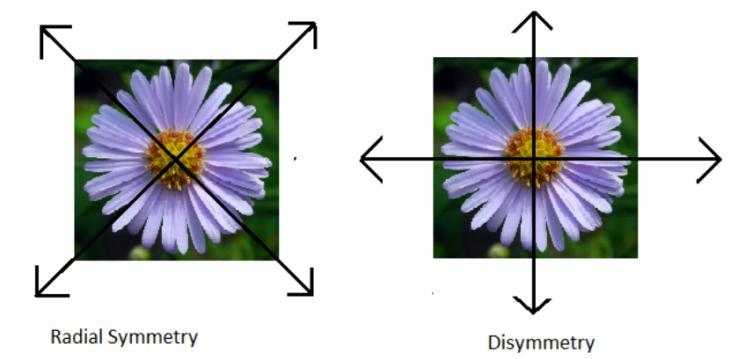
Which flower has a line of symmetry?
Answer
393.9k+ views
Hint: Floral symmetry refers to the ability of a flower, specifically its perianth, to be divided into two or more identical or mirror-image portions. Flowers, on the other hand, rarely have an axis of symmetry since their parts are spirally arranged.
Complete solution:-
Floral symmetry refers to the ability of a flower, specifically its perianth, to be divided into two or more identical or mirror-image portions. Flowers, on the other hand, rarely have an axis of symmetry since their parts are spirally arranged. Most flowers are actinomorphic ("star shaped," "radial"), which means they can be divided into three or more identical sectors that rotate around the flower's centre.
Each sector typically has one tepal, one petal, one sepal, and so on. The flower can be divided into symmetrical halves by the same number of longitudinal lines flowing through the axis, however this isn't always possible: There are two types of symmetry in flowers.

Symmetries are divided into two categories: radial and bilateral.
Actinomorphic flowers have radial symmetry, which means they may be divided into two equal halves on any radial plane passing through the centre. Flowers with bilateral symmetry are referred to as zygomorphic, meaning they can only be divided into two equal halves in one vertical plane. Mustard, datura, chilli flowers are actinomorphic, whereas, pea, Gulmohar, bean, Cassia are zygomorphic flowers.
Note:-
The body in radial symmetry takes the shape of a short or long cylinder or bowl, with a central axis from which the body parts radiate or are arranged in a regular pattern. The major axis is heteropolar, meaning it has opposite ends.
Complete solution:-
Floral symmetry refers to the ability of a flower, specifically its perianth, to be divided into two or more identical or mirror-image portions. Flowers, on the other hand, rarely have an axis of symmetry since their parts are spirally arranged. Most flowers are actinomorphic ("star shaped," "radial"), which means they can be divided into three or more identical sectors that rotate around the flower's centre.
Each sector typically has one tepal, one petal, one sepal, and so on. The flower can be divided into symmetrical halves by the same number of longitudinal lines flowing through the axis, however this isn't always possible: There are two types of symmetry in flowers.

Symmetries are divided into two categories: radial and bilateral.
Actinomorphic flowers have radial symmetry, which means they may be divided into two equal halves on any radial plane passing through the centre. Flowers with bilateral symmetry are referred to as zygomorphic, meaning they can only be divided into two equal halves in one vertical plane. Mustard, datura, chilli flowers are actinomorphic, whereas, pea, Gulmohar, bean, Cassia are zygomorphic flowers.
Note:-
The body in radial symmetry takes the shape of a short or long cylinder or bowl, with a central axis from which the body parts radiate or are arranged in a regular pattern. The major axis is heteropolar, meaning it has opposite ends.
Recently Updated Pages
The correct geometry and hybridization for XeF4 are class 11 chemistry CBSE

Water softening by Clarks process uses ACalcium bicarbonate class 11 chemistry CBSE

With reference to graphite and diamond which of the class 11 chemistry CBSE

A certain household has consumed 250 units of energy class 11 physics CBSE

The lightest metal known is A beryllium B lithium C class 11 chemistry CBSE

What is the formula mass of the iodine molecule class 11 chemistry CBSE

Trending doubts
State the laws of reflection of light

One Metric ton is equal to kg A 10000 B 1000 C 100 class 11 physics CBSE

Difference Between Prokaryotic Cells and Eukaryotic Cells

How do I convert ms to kmh Give an example class 11 physics CBSE

Give an example of a solid solution in which the solute class 11 chemistry CBSE

Describe the effects of the Second World War class 11 social science CBSE




